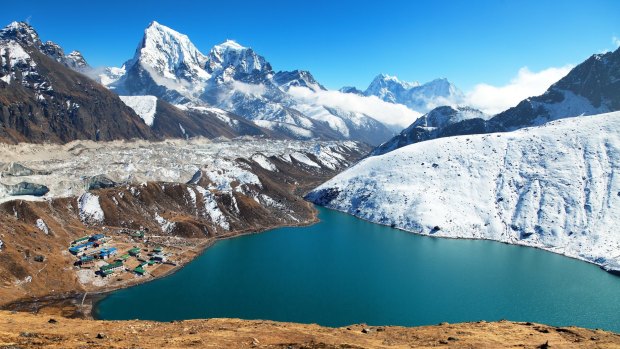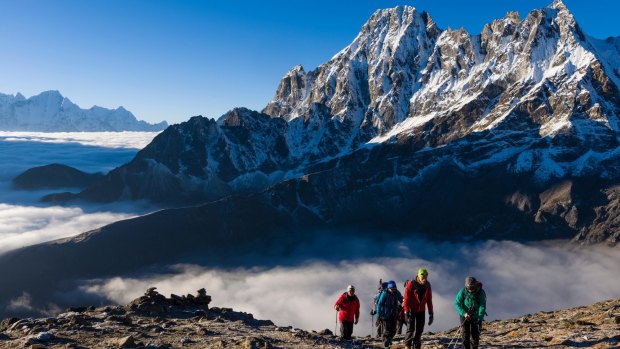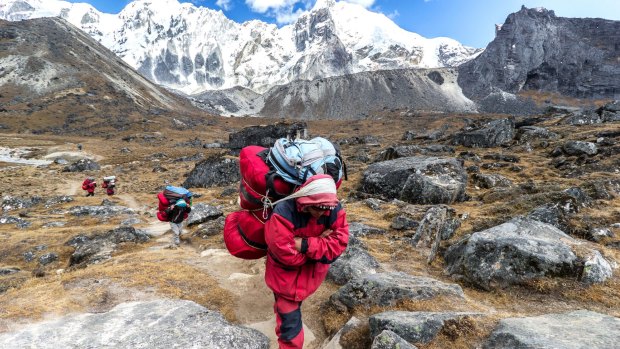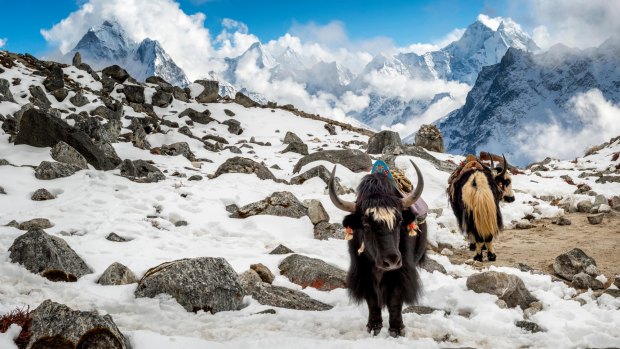This was published 5 years ago
Hiking in Nepal: Trekking to Everest Base Camp via Cho La
By Andrew Bain

Gokyo village and Ngozumba glacier from Gokyo Ri.Credit: Shutterstock
On the map in my hand, the trail to Cho La reads like a board game: "slippery path", "difficult icy crossing", "possibility of rocks falling", "danger of crevasses". The prospect of crossing this high Himalayan pass sounds as bleak as the rock rubble that litters the glacier I'm now hiking across at its foot.
Ahead of me rises a confronting wall of mountains, their summits split by Cho La, this pass that is to be my back door into Everest Base Camp. We've been walking for 11 days, and the busy main trail to base camp is now just six kilometres ahead, up and beyond Cho La, though it feels light years away.
Every year, more than 30,000 people trek to Everest Base Camp, with the vast majority of them following the well-worn path from Lukla through the Khumbu Valley. But alternatives exist, primarily in this route across Cho La that is so much more spectacular, challenging and rewarding than the direct base-camp trek.

For most trekkers, the ascent of Gokyo Ri is the literal high point of their journey.Credit: Alamy
Like all treks in the area, it begins with a flight from Kathmandu to Lukla, where planes all but belly-flop onto one of the world's most frightening airstrips.
The Cho La route diverges from the base-camp trail just beyond the Sherpa town of Namche Bazaar, where overnight rain has damped down the dust haze. In the clear air, the mountains, including Everest, sit in bas-relief against the sky.
For two hours, we walk in the surging tide of base-camp trekkers before the trail forks. Our journey is into the Gokyo Valley, rising beneath high cliffs where Himalayan tahr graze the slopes and a pair of vultures sail overhead on the thermals.

Porters with heavy loads after crossing Cho La Pass.Credit: Alamy
For the next four days, we'll follow the trail to the village of Gokyo, walking through a valley narrower and more spectacular than the adjoining Khumbu Valley. Waterfalls stand frozen in their winter poses, and Cho Oyu, the world's sixth-highest mountain, rises into view as a white sheet of ice blocking the way to Tibet. Yaks amble down the trail, and porters hurry past, barely slowed by their Herculean weights.
In Gokyo we pause for a day, doing as everyone here does – climbing the black peak of Gokyo Ri. For most trekkers, the ascent of this 5357-metre-high mountain is the literal high point of their journey, but for us it's another piece in the acclimatisation puzzle for Cho La, just two days ahead now.
On the morning of the Gokyo Ri climb, the lodge begins to stir before 5am as people prepare for dawn ascents. The climb is slow, laborious and spectacular, coiling up Gokyo Ri's slopes through a forest of cairns. Every few steps I pause, gulping down thin oxygen, then shuffling on.

Yaks at Lobuche base camp.Credit: Alamy
Almost three hours after setting out, I rise onto the prayer-flag-strewn summit, where briefly there is a ghostly glimpse of Everest's north face before it disappears under a ball of cloud.
Its loss does nothing to detract from the view. The highest of the high peaks of the Himalayas surround me, and the Ngozumpa Glacier – the longest glacier in the Himalayas – scratches its way through the mountains beside the frozen Gokyo Lakes.
Somewhere in my head, the whole journey to Everest Base Camp begins only now, in Gokyo. Everything until here has been preparation and acclimatisation, but as we walk out the next morning, we're finally heading for Cho La, crossing the mountains that separate us from the Khumbu Valley.
This day we'll trek across the Ngozumpa Glacier, resting a night at the tiny village on Thagnak on the glacier's opposite side. Mounds of ice and snow cover the glacier's surface, looking uncannily like sand dunes. It's as though we're walking across a high, frozen desert.
Elsewhere across the glacier, ice cliffs tower above lakes of melted water. At one lake, metres-long, straw-thin icicles hang from the edge of the ice, looking like tree roots dangling from a cliff. It's the sort of scene you just don't see on the main trail to base camp.
By lunchtime we're in Thagnak, a smattering of lodges stuffed beneath cliffs. Snow falls heavily as we walk in, and it continues through the afternoon, as it has every day for the past week, threatening to end our attempt to cross Cho La.
But by morning the world is as still as a painting. Even the streams don't flow, frozen into position by the sub-zero temperatures. Blue skies promise a warmth that never arrives, and as we begin the long climb from Thagnak towards the pass, first light is striking the tips of the mountains.
It is more than an hour before sunlight hits the valley floor, thawing fingers, toes and the stream as we come to a snow-covered ridge where everything becomes clear … as well as mentally murky.
Atop the ridge comes our first view of Cho La, a distinct saddle draped between two mountains. It's a daunting view, with the pass and mountains rising sheer from the glacier. It looks every bit as intimidating as the map suggests.
"You're f---ing kidding," I hear another trekker murmur.
And yet on we walk, crossing a glacier for the second consecutive day, ice crunching beneath our boots. It's an easy crossing, weaving between boulders and rubble as the pass draws nearer and more ominous. It feels like walking up to a city skyscraper and expecting to be able to climb it.
Briefly we stop, fitting crampons to our boots. As we do, a porter passes on his way to Cho La, a heavy load on his head and nothing more than a pair of flimsy runners on his feet.
Somehow, like alchemy, Cho La begins to gain texture as we walk nearer. A series of ledges and a long gully materialise across the slopes, and a thin trail of trekkers edge along the ledges like a game of Himalayan Donkey Kong.
What eventuates is a climb that's steep but uncomplicated. It's not the terrain that hurts; it's the thin air at 5400 metres. Within an hour we're standing on the pass, exhausted and exhilarated, surrounded by mountains and glaciers.
Pointing east is a long white glacier that's also our path off the pass. Stepping onto it is like treading on a cloud, with walls of blue ice draping down from the mountain walls around us.
The next morning, everything changes as we turn up into the Khumbu Valley. Approaching the ramshackle village of Lobuche, we meet the main base-camp trail at a junction so busy it almost needs a merging-traffic sign.
The flow of trekkers becomes a flood all the way to base camp, where a colourful city of tents begins to resemble Lego strewn across the valley floor, and porters carrying ungodly loads – six single mattresses in one case – look like semi trailers coming up the track.
Base camp is less a place than an idea, and the true treat here is not the camp itself, but Kala Pattar, the 5545-metre mountain that rises from near its edge.
Predawn climbs are standard on Kala Pattar, and we wake at 4am to thick fog that looks likely to steal the mountain's famous view. We walk out into darkness and cloud, but an hour later, as first light arrives, it becomes clear that we've climbed high above the cloud, which is packed thickly into the valleys far below us.
Slowly the rising sun lights the Himalayan peaks that have become so familiar over the past 14 days– Ama Dablam, Kantega, Thamserku, Cholatse, Nuptse. Fittingly, sunlight hits the hulking black pyramid of Everest last of all, since after all that I've seen on this journey on foot, this one mountain has gone from everything to just another part of the world's highest skyline.
FIVE OTHER EVEREST REGION TREKS
Everest Base Camp: The classic, heading straight up from Lukla to base camp.
Gokyo Ri: Veer off the base-camp trail to climb the mountain many believe to have the finest Everest view of all.
Three Passes: Skim past Everest as you cross Renjo La, Cho La and Kongma La.
Ama Dablam Base Camp: Turn off the Everest trail at Pangboche to reach the base camp for the mountain even more spectacular than Everest.
Island Peak: Scale one of Nepal's designated trekking peaks: 6189-metre Island Peak.
TRIP NOTES
MORE
FLY
Malaysia Airlines flies to Kathmandu from Melbourne and Sydney, transiting through Kuala Lumpur. Guided trips in the Everest region typically include flights from Kathmandu to Lukla.
TREK
World Expeditions runs a 21-day Everest Circuit & the Cho La trek, beginning and ending in Kathmandu and staying in its private permanent campsites and local lodges. Trips start at $3598. worldexpeditions.com
Andrew Bain was a guest of World Expeditions.
Sign up for the Traveller Deals newsletter
Get exclusive travel deals delivered straight to your inbox. Sign up now.